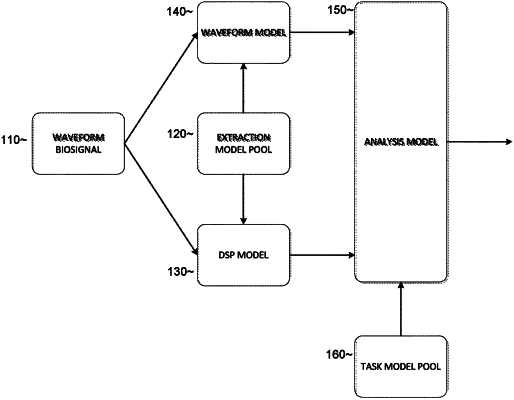| CPC A61B 5/316 (2021.01) [A61B 5/0533 (2013.01); A61B 5/245 (2021.01); A61B 5/318 (2021.01); A61B 5/369 (2021.01); A61B 5/389 (2021.01); A61B 5/398 (2021.01); A61B 5/7257 (2013.01); A61B 5/726 (2013.01); A61B 5/7264 (2013.01); A61B 5/7275 (2013.01); A61B 5/746 (2013.01); G16H 50/20 (2018.01); G06N 3/04 (2013.01); G06N 3/044 (2023.01); G06N 20/10 (2019.01)] | 8 Claims |

|
1. A method for performing a biosignal analysis task using a set of models, the method performed by at least one processor and comprising:
receiving an input biosignal, the input biosignal including a biosignal related to a heartbeat pattern, the biosignal including multiple types from among an electrocardiogram (ECG) signal, an electroencephalogram (EEG) signal, an electromyogram (EMG) signal, a mechanomyogram (MMG) signal, an electrooculography (EOG) signal, a galvanic skin response (GSR) signal, and a magnetoencephalogram (MEG) signal;
receiving information that identifies a plurality of types of the biosignal analysis task to be performed in association with the input biosignal, the plurality of types including determining a diagnosis of a heart-related condition associated with the input biosignal, clustering the input biosignal, classifying the input biosignal, and predicting a heart-related disease associated with the input biosignal;
accessing a storage configured to store information of first mapping that maps waveform models, of a set of waveform models, and biosignal analysis tasks in association with each other and configured to store information of second mapping that maps digital signal processing (DSP) models, of a set of DSP models, and the biosignal analysis tasks in association with each other;
selecting, by using a waveform feature extraction module, a waveform model, from the set of waveform models, based on the information that identifies a first type, among the identified plurality of types of the biosignal analysis task to be performed and the information of the first mapping, wherein the waveform model includes a combination of two or more from a recurrent neural network (RNN), a convolutional neural network (CNN), and a support vector machine (SVM);
selecting, by using a DSP feature extraction module, a DSP model, from the set of DSP models, based on the information that identifies a second type, among the identified plurality of types of the biosignal analysis task to be performed and the information of the second mapping;
simultaneously extracting, from the input biosignal, a first type of feature of the input biosignal by using the waveform model, selected by the waveform feature extraction module, and a second type of feature of the input biosignal by using the DSP model, selected by the DSP feature extraction module, wherein the first type of feature includes a waveform of the input biosignal, an amplitude of the input biosignal, and a frequency of the input biosignal, and wherein the DSP feature extraction module performs a signal processing algorithm including a fast Fourier transform, a wavelet transform, and a filter, to obtain the second type of feature;
selecting an analysis model, from a set of analysis models, to perform the biosignal analysis task associated with the input biosignal, based on the first type of feature and the second type of feature, the selected analysis model being configured to receive the extracted first and second types of features and produce final outcomes including a classification result, an outlier alarms, and a predicted diagnosis based on the received extracted first and second types of features, wherein
the storage is configured to store information that maps analysis models, biosignal analysis tasks, waveform models, and DSP models in association with each other, and the selecting the analysis model is performed by referring to the storage using the biosignal analysis task, the selected waveform model, and the selected DSP model,
the set of analysis models includes a plurality of statistical process control algorithms for biosignal monitoring and alarming, a plurality of predictive models and classifier models for computer-aided diagnosis, and a plurality of statistical tools for general pathological status calculation, and
the selected analysis model is configured to perform a multi-symptom diagnosis by using a dependency between symptoms, a feedback link being added from the diagnosed multi-symptom to feature extraction modules; and
performing, using the analysis model, the identified plurality of types of the biosignal analysis task based on the first type of feature and the second type of feature extracted simultaneously by the waveform model and the DSP model to diagnose the heart-related condition associated with the input biosignal, cluster the input biosignal, classify the input biosignal, or predict the heart-related disease associated with the input biosignal,
wherein the waveform feature extraction module and the DSP feature extraction module are based on machine learning, and parameters for the waveform feature extraction module and parameters for the DSP feature extraction module are separately trained and selected, to model a relationship between an input of a biosignal and an output of each of the plurality of types of the biosignal analysis task.
|